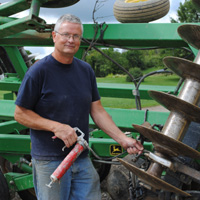News Archives
Contact:
Lana Cusick, 202-720-3325
CROP INSURANCE AS AN INVESTMENT
MACHIAS, NY, Oct 12, 2010 - An interest in machinery and growing things brought Brian Andrews to farming. The satisfaction of growing a good crop keeps him there, with a little help from crop insurance.
 |
Brian Andrews
New York State Field Crops Farmer
|
After graduating from Alfred State College with a major in agricultural engineering, Andrews tried his hand at both machinery sales and hands-on farming. He started growing field crops for himself in 1980, later diversifying from corn and hay to growing multiple of crops throughout the growing seasons. “Our farm consists of about 1,200 acres of corn, 1,200 acres of soybeans, 500 acres of peas, and 400 of wheat and generally about 100-150 of oats.”
Andrews initially signed up for crop insurance because “it was a requirement of the lending agencies I was working with,” but he soon saw it as a necessity and an important investment. “Farming is risky enough as it is, even with crop insurance,” he explains. “If you don’t have crop insurance, you’re leaving yourself wide open to a big drop in income if you have a disaster.”
Covering forty miles from end to end, Andrews’ fields experience variable microclimates and weather patterns, so he splits the farm into about 28 insurable units. This allows him to collect insurance payments when disaster strikes an isolated area, or certain type of crop.
Although he is satisfied with catastrophic coverage for oats and wheat, his “minor crops,” Andrews carries buy-up coverage for corn, peas and beans. “We carry the buy-up coverage on that simply because it’s so expensive to plant the crop.” Those crops have also proven more prone to damage in severe weather. He recalls one early October hail storm about 10 years prior, that knocked acres of ripe soybeans from the pods to the ground just as combining had begun. “It was definitely a good idea that we had crop insurance that year,” he nods. “I would say [crop insurance] made a difference of probably $90,000 to $100,000, and that’s above the premium.”
Past experiences cause Andrews to call crop insurance one of his “more important investments.” “[The premiums] seem like a steep expenditure,” but “given the thin profit margins that are there, you have to be able to cover your cost. It doesn’t take very long to make one or two mistakes and you’re almost out of business.”
Andrews also uses crop insurance to price his crops ahead when prices are favorable. For example, he priced his 2009 corn ahead when prices spiked in 2008, with assurance that the crop insurance payment would allow him to cover his deliveries in the event of a disaster. “Crop insurance has helped me to price ahead and
increase my revenue that way, as well as protect me against any loss,” he explains.
This story is a New York State Department of Agriculture and Markets (NYSDAM) publication from Federal Project Fiscal Year 2009-10. NYSDAM conducts a crop insurance and risk management education program in partnership with RMA. For more information, please see http://www.agriculture.ny.gov/.
|